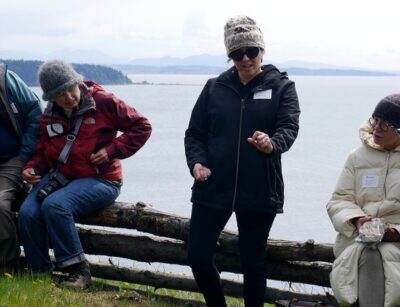
Poet and Lummi Nation member Rena Priest on Pen’e’nex’weng (now known as Vendovi Island)
April is National Poetry Month. It’s also the month when camas and other wildflowers in the islands bloom forth with their showiest peaks of spring color—and nowhere more so than on SJPT’s Vendovi Island Preserve.
We were honored when renowned poet Rena Priest, a member of the Lummi Nation who, last year, completed a two-year term as Washington state’s Poet Laureate, wrote a poem titled “Creation Story.” The poem tells how the island we now call Vendovi got its true name, Pen’e’nex’weng—or as her poem says, “the island where we go to p’aneq, to dig for xwelol” (camas).
In observance of National Poetry Month, and to honor the cultural importance of camas and other wildflowers in Coast Salish Indigenous food ways, we feel privileged to share Rena’s poem.
Creation Story
By Rena Priest
With a title like that, I can see how
you might assume this is a poem
about life breathed into clay,
and the man’s rib,
and the woman, and the snake.
But no. It’s not that one
with the despot god
and all his “Thou shalt not.”
This is the one about Kwome and Kwelshan,*
two mountains standing regal in my homelands,
and how through their parting of ways
the islands of the Salish Sea came into being.
A long time ago, the two mountains were married.
For some reason, who knows why?—
one day Kwome decided it was time
to be on her way.
She had a flare for the dramatic,
and her salty tears
became the swirling eddies of the Salish Sea.
Soon, all that crying made her tired.
She set down her texwitch, her bow
to have a bit of xwelol, camas
and when she got up to go,
she forgot her texwitch,
and dropped a little piece of her xwelol.
These became islands, that the people now know
as Texwitch, the island shaped like a bow
and Pen’e’nex’weng the island where we go
to p’aneq, to dig for xwelol.
She went along this way, leaving gifts
For the xwel’nexw’qen, the people.
And the gifts have stories to map the bounty
in the garden of the Salish Sea.
When she arrived where she stands today,
She decided that was far enough away.
Sometimes on a clear day, you can see her
all the way from her old homelands
where once she stood with handsome Kwelshan.
And he likes to catch a glimpse of her
glowing majestically in the rare sunshine.
He could look at her and nothing else
for the rest of his life. But soon she decides
it can’t go on this way, and she draws the clouds
around her face to disappear back into the gray,
and that my dears, is the reason why
it’s cloudy here all the time.
Author’s note: This story is used with permission of the Lummi Schelengen Office. It is important to acknowledge that the story originates from the Lummi oral tradition, a living tradition, and there are many different versions. The story was originally told to me by Matt Warbus, and I have heard it from several other people over the years. My interpretation of the story is based on my own understanding of it, and there may be other interpretations that are different.
* Editor’s note: Kwome is now generally referred to as Mount Ranier; Kwelshan is also known as Mount Baker; Texwitch is now also called Eliza Island; and Pen’e’nex’weng is also known today as Vendovi Island.
“Creation Story” (c) Rena Priest was recently published in Writing the Land: Streamlines (NatureCulture LLC, Northfield, MA, 2023), edited by Lis McLoughlin, Ph.D. “Writing the Land” is a project that fosters collaboration between land trusts’ protected lands and poets all across the U.S. We wish to express our gratitude to Lis McLoughlin for inviting SJPT to participate, and to Rena Priest for her gracious contribution to the project.
Copies of Writing the Land: Streamlines (which includes “Creation Story” and more background on SJPT and Pen’e’nex’weng, as well as sections featuring poems about other land trusts’ protected lands) are available for purchase from the publisher here.
Watch a video version of “Creation Story” (made with Rena Priest’s permission):
